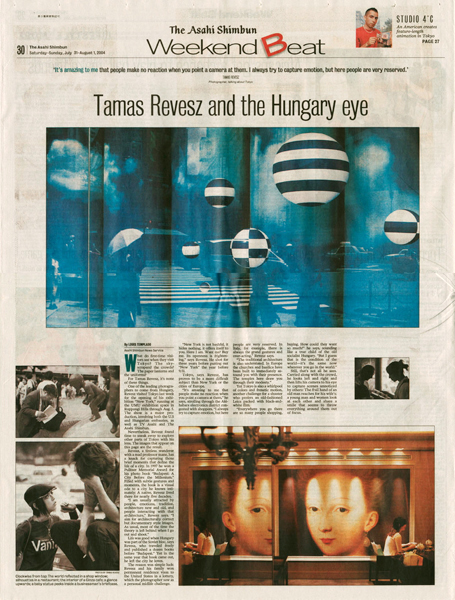|
|
|
Tamas
Revesz and the Hungary Eye
By LOUIS TEMPLADO, International
Herald Tribune/Asahi Shimbu, July 31,2004
"
It's amazing to me that people make no reaction when you point a camera at
them. I always try to capture emotion, but here people are very reserved."
TAMAS REVESZ Photographer, talking about Tokyo
What do first-time visitors see when they visit Tokyo? The skyscrapers? The
crowds? The paper lanterns and the uniforms?
For Tamas Revesz, it's none of these things.
One of the leading photographers to come from Hungary, Revesz visited Tokyo
last week for the opening of his exhibition "New York", running
at the UMU exhibition space in Roppongi Hills through Aug. 5. The show is
a major production, involving both the U.S and Hungarian embassies, as well
as TV Asahi and The Asahi Shimbun.
Nevertheless, Revesz found time to sneak away to explore other parts of Tokyo
with his lens. The images that appear on this page are the result.
Revesz, a tireless wanderer with a mad professor mane, has a knack for capturing
those brief moments that define the life of a city. In 1997 he won a Pulitzer
Memorial Award for his photo book "Budapest: A City Before the Millenium".
Filled with subtle gestures and moments, the book is a visual ode to a city
he knows intimately: A native, Revesz lived there for nearly five decades.
"I am usually attracted by people, emotions, tradition, architecture
new and old, and people interacting with that architecture", Revesz says.
"I aim for architecturally correct but documentary style images. As usual,
most of the time the theory is left behind when I go out and shoot".
Life was good when Hungary was part of the Soviet bloc, says Revesz, who traveled
freely and published a dozen books before "Budapest". Yet in the
same year that book came out, he left the city he loves.
The reason was simple luck: Revesz and his family won permanent residence
visas to the United States in a lottery, which the photographer saw as a personal
midlife challenge.
"New York is not bashful, it hides nothing, it offers itself to you.
Here I am. Want me? Buy me. Its openness is frightening", says Revesz.
He shot for three years before putting out "New York" the year before
9/11.
Tokyo, says Revesz, has proven to be a more difficult subject than New York
or the cities of Europe.
" It's amazing to me that people make no reaction when you point a camera
at them", he says, strolling through the Akihabara electronics district
congested with shoppers. "I always try to capture emotion, but here people are very reserved.
In Italy, for example, there is always the grand gestures and over-acting,"
Revesz says. "The traditional architecture is also understated. In Europe the churches
and basilica have been built to immediately astound you with their presence.
The temples here draw you through their modesty".
Yet Tokyo is also a whirlpool of colors and frenetic motion, another challenge
for a shooter who prefers an old-fashioned Leica packed with black-and-white
film.
"Everywhere you go there are so many people shopping, buying. How could
they want so much?" he says, sounding like a true child of the old socialist
Hungary. "But I guess that is the condition of the world-it's the same
now wherever you go in the world."
Still, that's not all he sees. Carried along with the crowd, he looks left
and right and then lifts his camera to his eye to capture scenes unnoticed
by others: The frail hand of an old man reaches for his wife's; a young man
and women look at each other and share a smile that seems to throw everything
around them out of focus.
|


